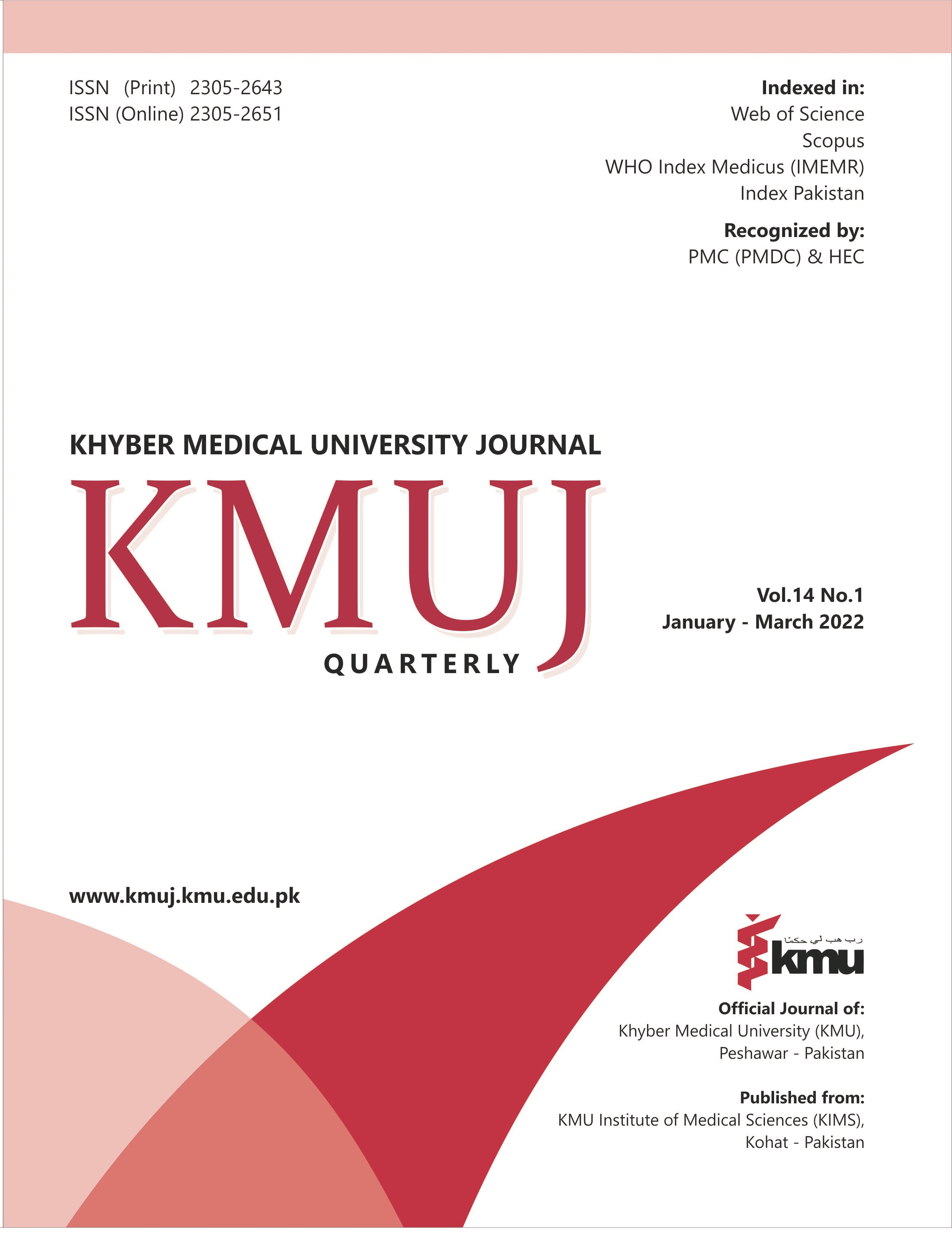FREQUENCY OF 25-HYDROXY VITAMIN D DEFICIENCY IN PATIENTS WITH MULTIPLE SCLEROSIS
Main Article Content
Abstract
OBJECTIVE: To determine the frequency of 25-hydroxy vitamin-D deficiency in Patients with multiple sclerosis (MS).
METHODS: This cross-sectional study was conducted at Civil Hospital Karachi, Pakistan from January to December 2019. One hundred and sixty five diagnosed cases of MS of either gender, aging 20-55 years, not taking vitamin-D supplements, steroids and could go outside in the sun were selected through non-probability consecutive sampling technique. Patients having history of rickets, parathyroid disease, chronic liver or renal diseases were excluded. Blood sample was taken to measure 25-hydroxyl vitamin D3 levels. A level of <20 ng/ml was considered as vitamin-D deficient. Logistic regression analysis was used to identify determinants.
RESULTS: Out of 165 MS patients, 106 (64.24%) were females, 66 (40%) had income between PKR 10000-25000, 51 (30.9%) were illiterate and 12 (7.3%) had graduate level education. Majority (n=101; 61.21%) had relapsing-remitting MS. Mean age of enrolled participants was 32.92±8.19 years and mean duration of MS was 2.17±0.84 years. Ninety-nine (60%) patients had history of adequate sun exposure. Vitamin-D deficiency in MS patients was 55 (33.3%). Female patients with MS had 2.9 times more likely to be vitamin-D deficient compared to male patients (95% CI: 1.3-6.5). Vitamin-D deficiency In MS patients having no or primary level education patients was recorded in 38 (69.1%) patients as compared to 17 (31.9%) case having secondary or higher education (p-value=0.046).
CONCLUSION: Vitamin-D deficiency is common in MS patients. Female and less educated MS patients are at a higher risk of being vitamin-D deficient.
Article Details
Work published in KMUJ is licensed under a
Creative Commons Attribution 4.0 License
Authors are permitted and encouraged to post their work online (e.g., in institutional repositories or on their website) prior to and during the submission process, as it can lead to productive exchanges, as well as earlier and greater citation of published work.
(e.g., in institutional repositories or on their website) prior to and during the submission process, as it can lead to productive exchanges, as well as earlier and greater citation of published work.
References
Voet S, Prinz M, van Loo G. Microglia in central nervous system inflammation and multiple sclerosis pathology. Trends Mol Med 2019;25(2):112-23. https://doi.org/10.1016/j.molmed.2018.11.005
Kocovska E, Gaughran F, Krivoy A, Meier UC. Vitamin-D deficiency as a potential environmental risk factor in multiple sclerosis, schizophrenia, and autism. Front Psychiatry 2017;8:47. https://doi.org/10.3389/fpsyt.2017.000477
Runia TF, Hop WC, de Rijke YB, Buljevac D, Hintzen RQ. Lower serum vitamin D levels are associated with a higher relapse risk in multiple sclerosis. Neurology 2012;79(3):261-6.
https://doi.org/10.1212/WNL.0b013e31825fdec7
Thouvenot E, Orsini M, Daures JP, Camu W. Vitamin D is associated with degree of disability in patients with fully ambulatory relapsing-remitting multiple sclerosis. Eur J Neurol 2015;22(3):564-9. https://doi.org/10.1111/ene.12617
Mansouri B, Asadollahi S, Heidari K, Fakhri M, Assarzadegan F, Nazari M, et al. Risk factors for increased multiple sclerosis susceptibility in the Iranian population. J Clin Neurosci 2014;21(12):2207-11. https://doi.org/10.1016/j.jocn.2014.04.020
Harandi AA, Shahbeigi S, Pakdaman H, Fereshtehnejad SM, Nikravesh E, Jalilzadeh R. Association of serum 25(OH) vitamin D3 concentration with severity of multiple sclerosis. Iran J Neurol 2012;11(2):54-8.
Smolders J, Menheere P, Kessels A, Damoiseaux J, Hupperts R. Association of vitamin D metabolite levels with relapse rate and disability in multiple sclerosis. Mult Scler 2008;14(9):1220-4. https://doi.org/10.1177/1352458508094399
Pierrot-Deseilligny C, Souberbielle JC. Vitamin D and multiple sclerosis: an update. Mult Scler Relat Disord 2017;14:35-45.https://doi.org/10.1016/j.msard.2017.03.014
Thompson AJ, Banwell BL, Barkhof F, Carroll WM, Coetzee T, Comi G, et al. Diagnosis of multiple sclerosis: 2017 revisions of the McDonald criteria. Lancet Neurol 2018;17(2):162-73. https://doi.org/10.1016/S1474-4422(17)30470-2
Riaz H, Finlayson AE, Bashir S, Hussain S, Mahmood S, Malik F, et al. Prevalence of Vitamin D deficiency in Pakistan and implications for the future. Expert Rev Clin Pharmacol 2016;9(2):329-38. https://doi.org/10.1586/17512433.2016.1122519
Bouillon R. Comparative analysis of nutritional guidelines for vitamin D. Nat Rev Endocrinol 2017;13(8):466-79. https://doi.org/10.1038/nrendo.2017.31
Ferre L, Sferruzza G, Mascia E, Clarelli F, Dalla Costa G, Radaelli M, et al. Baseline vitamin D levels and multiple sclerosis activity in relapsing remitting patients treated with fingolimod. Neurol Sci 2016;39(8):1467-70. https://doi.org/10.1007/s10072-018-3440-0
Shah Z, Wasay M, Chaudhry BZ, Fredrikson S. Multiple sclerosis in Pakistan: Current status and future perspective. J Neurol Sci 2020:418:117066. https://doi.org/10.1016/j.jns.2020.117066
Raja V, Afzal N, Roy N, ur Rehman J, Avinash BK. Frequency of Vitamin D Deficiency Among Patients of Multiple Sclerosis in Pakistan. J Med Health Studies 2020;1(1):17-22.
Siddiqee MH, Bhattacharjee B, Siddiqi UR, Meshbah ur Rahman M. High prevalence of vitamin D deficiency among the South Asian adults: a systematic review and meta-analysis. BMC Public Health 2021;21(1):2-18. https://doi.org/10.1186/s12889-021-11888-1
Shamsi U, Azam I, Shamsi A, Shamsi D, Callen D. Frequency and determinants of vitamin D deficiency among premenopausal and postmenopausal women in Karachi Pakistan. BMC Womens Health 2021;21(1):2-8. https://doi.org/10.1186/s12905-021-01339-9
Syed F, Latif MSZ, Ahmed I, Bibi S, Ullah S, Khalid N. Vitamin D deficiency in Pakistani population: critical overview from 2008 to 2018. Nutrition Food Science 2020;50(1):105-15. https://doi.org/10.1108/NFS-03-2019-0105
Vorobeychik G, Black D, Cooper P, Cox A. Multiple sclerosis and related challenges to young women's health: Canadian expert review. Neurodegener Dis Manag 2020;10(2s):1-13. https://doi.org/10.2217/nmt-2020-0010
Goulden R, Ibrahim T, Wolfson C. Is high socioeconomic status a risk factor for multiple sclerosis? A systematic review. Eur J Neurol 2015;22(6):899-911. https://doi.org/10.1111/ene.12586
Bjørnevik K, Riise T, Cortese M, Holmøy T, Kampman MT, Magalhaes S, et al. Level of education and multiple sclerosis risk after adjustment for known risk factors: The EnvIMS study. Mult Scler 2016;22(1):104-11. https://doi.org/10.1177%2F1352458515579444
Bartosik-Psujek H, Psujek M. Vitamin D as an immune modulator in multiple sclerosis. Neurol Neurochir Pol 2019;53(2):113-22. https://doi.org/10.5603/PJNNS.a2019.0015
Smolders J, Torkildsen Ø, Camu W, Holmøy T. An update on vitamin D and disease activity in multiple sclerosis. CNS Drugs 2019;33(12):1187-99. https://doi.org/10.1007/s40263-019-00674-8
Sternberg Z. Cardiovascular autonomic dysfunction: link between multiple sclerosis osteoporosis and neurodegeneration. Neuromolecular Med 2018;20(1):37-53. https://doi.org/10.1007/s12017-018-8481-2
